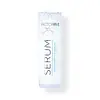What's inside
What's inside
 Key Ingredients
Key Ingredients

 Benefits
Benefits

 Concerns
Concerns

 Ingredients Side-by-side
Ingredients Side-by-side

Human Bone Marrow Stem Cell Conditioned Media
Skin ConditioningWater
Skin ConditioningAloe Barbadensis Leaf Juice
Skin ConditioningGlycerin
HumectantNiacinamide
SmoothingSodium Ascorbyl Phosphate
AntioxidantPEG-8/Smdi Copolymer
Hydroxyethylcellulose
Emulsion StabilisingXanthan Gum
EmulsifyingPhenoxyethanol
PreservativeAcetyl Octapeptide-3
HumectantBis(Tripeptide-1) Copper Acetate
Skin ConditioningSodium Hyaluronate
HumectantLecithin
EmollientAcmella Oleracea Extract
Skin ProtectingPolysorbate 20
EmulsifyingCamellia Sinensis Leaf Extract
AntimicrobialEthylhexylglycerin
Skin ConditioningCitric Acid
BufferingDisodium EDTA
Palmitoyl Tripeptide-37
Skin ConditioningParfum
MaskingHuman Bone Marrow Stem Cell Conditioned Media, Water, Aloe Barbadensis Leaf Juice, Glycerin, Niacinamide, Sodium Ascorbyl Phosphate, PEG-8/Smdi Copolymer, Hydroxyethylcellulose, Xanthan Gum, Phenoxyethanol, Acetyl Octapeptide-3, Bis(Tripeptide-1) Copper Acetate, Sodium Hyaluronate, Lecithin, Acmella Oleracea Extract, Polysorbate 20, Camellia Sinensis Leaf Extract, Ethylhexylglycerin, Citric Acid, Disodium EDTA, Palmitoyl Tripeptide-37, Parfum
Water
Skin ConditioningGlycerin
HumectantCaprylic/Capric Triglyceride
MaskingHydroxyethyl Acrylate/Sodium Acryloyldimethyl Taurate Copolymer
Emulsion StabilisingSqualane
EmollientAminopropyl Ascorbyl Phosphate
AntioxidantSodium Hyaluronate
HumectantHydrolyzed Sodium Hyaluronate
Skin ConditioningCutaneous Lysate
MoisturisingTetrapeptide-21
Skin ConditioningPalmitoyl Tripeptide-1 Acetate
Skin ConditioningButylene Glycol
HumectantEthylhexylglycerin
Skin ConditioningPullulan
Acetyl Glucosamine
Skin ConditioningEthylene/Acrylic Acid Copolymer
Emulsion StabilisingPolysorbate 60
EmulsifyingProline
Skin ConditioningArginine
MaskingGlycine
BufferingGlutamine
Skin ConditioningChlorphenesin
AntimicrobialNannochloropsis Oculata Extract
HumectantCapryloyl Carnosine
Skin ConditioningPoloxamer 338
EmulsifyingSilica
AbrasiveTrifluoroacetyl Tripeptide-2
Skin ConditioningDextran
Sorbitan Isostearate
EmulsifyingPotassium Sorbate
PreservativeSodium Benzoate
MaskingTocopherol
AntioxidantDisodium EDTA
Sodium Hydroxide
BufferingPhenoxyethanol
PreservativeWater, Glycerin, Caprylic/Capric Triglyceride, Hydroxyethyl Acrylate/Sodium Acryloyldimethyl Taurate Copolymer, Squalane, Aminopropyl Ascorbyl Phosphate, Sodium Hyaluronate, Hydrolyzed Sodium Hyaluronate, Cutaneous Lysate, Tetrapeptide-21, Palmitoyl Tripeptide-1 Acetate, Butylene Glycol, Ethylhexylglycerin, Pullulan, Acetyl Glucosamine, Ethylene/Acrylic Acid Copolymer, Polysorbate 60, Proline, Arginine, Glycine, Glutamine, Chlorphenesin, Nannochloropsis Oculata Extract, Capryloyl Carnosine, Poloxamer 338, Silica, Trifluoroacetyl Tripeptide-2, Dextran, Sorbitan Isostearate, Potassium Sorbate, Sodium Benzoate, Tocopherol, Disodium EDTA, Sodium Hydroxide, Phenoxyethanol
Ingredients Explained
These ingredients are found in both products.
Ingredients higher up in an ingredient list are typically present in a larger amount.
Disodium EDTA plays a role in making products more stable by aiding other preservatives.
It is a chelating agent, meaning it neutralizes metal ions that may be found in a product.
Disodium EDTA is a salt of edetic acid and is found to be safe in cosmetic ingredients.
Learn more about Disodium EDTAEthylhexylglycerin (we can't pronounce this either) is commonly used as a preservative and skin softener. It is derived from glyceryl.
You might see Ethylhexylglycerin often paired with other preservatives such as phenoxyethanol. Ethylhexylglycerin has been found to increase the effectiveness of these other preservatives.
Glycerin is already naturally found in your skin. It helps moisturize and protect your skin.
A study from 2016 found glycerin to be more effective as a humectant than AHAs and hyaluronic acid.
As a humectant, it helps the skin stay hydrated by pulling moisture to your skin. The low molecular weight of glycerin allows it to pull moisture into the deeper layers of your skin.
Hydrated skin improves your skin barrier; Your skin barrier helps protect against irritants and bacteria.
Glycerin has also been found to have antimicrobial and antiviral properties. Due to these properties, glycerin is often used in wound and burn treatments.
In cosmetics, glycerin is usually derived from plants such as soybean or palm. However, it can also be sourced from animals, such as tallow or animal fat.
This ingredient is organic, colorless, odorless, and non-toxic.
Glycerin is the name for this ingredient in American English. British English uses Glycerol/Glycerine.
Learn more about GlycerinPhenoxyethanol is a preservative that has germicide, antimicrobial, and aromatic properties. Studies show that phenoxyethanol can prevent microbial growth. By itself, it has a scent that is similar to that of a rose.
It's often used in formulations along with Caprylyl Glycol to preserve the shelf life of products.
Sodium Hyaluronate is hyaluronic acid's salt form. It is commonly derived from the sodium salt of hyaluronic acid.
Like hyaluronic acid, it is great at holding water and acts as a humectant. This makes it a great skin hydrating ingredient.
Sodium Hyaluronate is naturally occurring in our bodies and is mostly found in eye fluid and joints.
These are some other common types of Hyaluronic Acid:
Learn more about Sodium HyaluronateWater. It's the most common cosmetic ingredient of all. You'll usually see it at the top of ingredient lists, meaning that it makes up the largest part of the product.
So why is it so popular? Water most often acts as a solvent - this means that it helps dissolve other ingredients into the formulation.
You'll also recognize water as that liquid we all need to stay alive. If you see this, drink a glass of water. Stay hydrated!
Learn more about Water